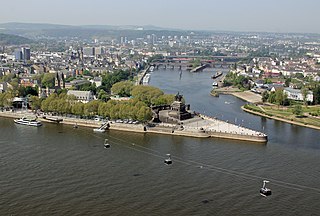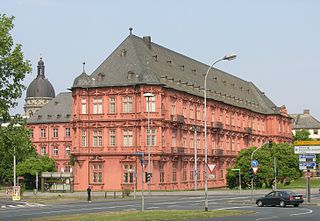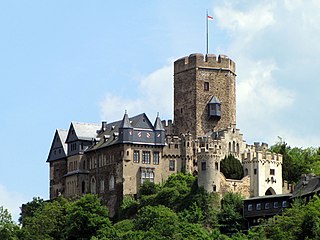
The Martinsburg is a former plains castle in Mainz. It lay on the banks of the Rhine, adjacent to the space where the Electoral Palace now stands. [1]

The Martinsburg is a former plains castle in Mainz. It lay on the banks of the Rhine, adjacent to the space where the Electoral Palace now stands. [1]
The castle was built from 1478 to 1481 at the order of Diether von Isenburg. Its position suggests that the Archbishop and Elector did not have it built as a defense against strangers, but as a retreat against the citizens of the city of Mainz. [1] The actual location of the electoral residence in the city center, next to the Cathedral, had become uncertain in the Mainz Diocesan Feud. The location of the castle on the banks of the Rhine on the other hand allowed a quick escape to the other residence places Eltville and Aschaffenburg. The arrangement of the trench towards the city favors this thesis.
Napoleon finally decided on the end of Martinsburg at the beginning of the 19th century. In 1806 or 1807 the castle was demolished in favor of the bridge and harbor construction. [2] As a testimony of their existence a few stone blocks of its walls in the former trench can be seen in front of the electoral castle towards the river Rhine today.

Cardinal Albert of Brandenburg was a German cardinal, elector, Archbishop of Mainz from 1514 to 1545, and Archbishop of Magdeburg from 1513 to 1545.

Mainz, previously known in English as Mentz or Mayence, is the capital and largest city of Rhineland-Palatinate, Germany.

Koblenz is a German city on the banks of the Rhine and the Moselle, a multinational tributary.

The Electorate of Mainz, previously known in English as Mentz and by its French name Mayence, was one of the most prestigious and influential states of the Holy Roman Empire. In the Roman Catholic hierarchy, the Archbishop-Elector of Mainz was also the Primate of Germany, a purely honorary dignity that was unsuccessfully claimed from time to time by other archbishops. There were only two other ecclesiastical Prince-electors in the Empire: the Electorate of Cologne and the Electorate of Trier.

The Electorate of Cologne, sometimes referred to as Electoral Cologne, was an ecclesiastical principality of the Holy Roman Empire that existed from the 10th to the early 19th century. It consisted of the Hochstift — the temporal possessions — of the Archbishop of Cologne, and was ruled by him in his capacity as prince-elector. There were only two other ecclesiastical prince-electors in the Empire: the Electorate of Mainz and the Electorate of Trier. The Archbishop-Elector of Cologne was also Arch-chancellor of Italy and, as such, ranked second among all ecclesiastical and secular princes of the Empire, after the Archbishop-Elector of Mainz, and before that of Trier.
Heidesheim am Rhein is an Ortsbezirk (borough) of the town Ingelheim am Rhein in the Mainz-Bingen district in Rhineland-Palatinate, Germany. Before July 2019, it was a separate municipality belonging to the former Verbandsgemeinde Heidesheim am Rhein, of which it was the administrative seat. Heidesheim was one of the biggest municipalities in Rhenish Hesse.

Oppenheim is a town in the Mainz-Bingen district of Rhineland-Palatinate, Germany. The town is a well-known wine center, being the home of the German Winegrowing Museum, and is particularly known for the wines from the Oppenheimer Krötenbrunnen vineyards.

The House of Schönborn[ˈʃøːnbɔrn] is the name of an ancient noble and mediatised formerly sovereign family of the former Holy Roman Empire.
Oberlahnstein is a part of the city of Lahnstein in Rhineland-Palatinate in Germany. It lies on the right bank of the Rhine, at the confluence of the Lahn 4 m. above Koblenz, on the Right Rhine railway from Cologne to Frankfurt-on-Main.

Lahnstein is a verband-free town of Rhein-Lahn-Kreis in Rhineland-Palatinate, Germany. It is situated at the confluence of the Lahn with the Rhine, approximately 6 kilometres (3.7 mi) south of Koblenz. Lahnstein was created in 1969 by the merger of the previously independent towns of Oberlahnstein on the south side of the Lahn and Niederlahnstein on the north side. In 2020, it had a population of 18,030.

Eltville am Rhein is a town in the Rheingau-Taunus-Kreis in the Regierungsbezirk of Darmstadt in Hesse, Germany. It lies on the German Timber-Frame Road.

The Electorate of Trier was an ecclesiastical principality of the Holy Roman Empire that existed from the end of the 9th to the early 19th century. It was the temporal possession of the prince-archbishop of Trier who was, ex officio, a prince-elector of the empire. The other ecclesiastical electors were the electors of Cologne and Mainz.

The Electoral Palace in Mainz is the former city Residenz of the Prince-elector and Archbishop of Mainz. It is one of the important Renaissance buildings in Germany.

The Battle of Mainz saw a Habsburg army led by François Sebastien Charles Joseph de Croix, Count of Clerfayt launch a surprise assault against four divisions of the French Army of Rhin-et-Moselle directed by François Ignace Schaal. The right-hand French division fled the battlefield, compelling the other three divisions to retreat with the loss of their siege artillery and many casualties. The War of the First Coalition action was fought near the city of Mainz in the today state of Rhineland-Palatinate in Germany.

In the siege of Mainz, from 14 April to 23 July 1793, a coalition of Prussia, Austria, and other German states led by the Holy Roman Empire besieged and captured Mainz from revolutionary French forces. The allies, especially the Prussians, first tried negotiations, but this failed, and the bombardment of the city began on the night of 17 June.

Stolzenfels Castle is a former medieval fortress castle ("Burg") turned into a palace, near Koblenz on the left bank of the Rhine, in the state of Rhineland-Palatinate, Germany. Stolzenfels was a ruined 13th-century castle, gifted to the Prussian Crownprince, Frederick William in 1823. He had it rebuilt as a 19th-century palace in Gothic Revival style. Today, it is part of the UNESCO World Heritage Site Upper Middle Rhine Valley.

The Electoral Palace in Koblenz, was the residence of the last Archbishop and Elector of Trier, Clemens Wenceslaus of Saxony, who commissioned the building in the late 18th century. In the mid-19th century, the Prussian Crown Prince had his official residence there during his years as military governor of the Rhine Province and the Province of Westphalia. It now houses various offices of the federal government.

Lahneck Castle is a medieval fortress located in the city of Lahnstein in Rhineland-Palatinate, Germany, south of Koblenz. The 13th-century castle stands on a steep rock salient above the confluence of the Lahn River with the Rhine, opposite Stolzenfels Castle, in the district of Oberlahnstein. Its symmetrical plan, an oblong rectangle, is typical of the later castles of the time of the Hohenstaufen. The pentagonal shape of the bergfried is rare for castle towers.

The Wood Tower is a mediaeval tower in Mainz, Germany, with the Iron Tower and the Alexander Tower one of three remaining towers from the city walls. Its current Gothic appearance dates to the early 15th century. It is so named because wood used to be piled next to it on the bank of the Rhine.

The Old Arsenal, also referred to as Zum Sautanz, was the central arsenal of the fortress of Mainz during the 17th and 18th century. In his function it was succeeded by the new arsenal. Currently the renaissance building is used by the Rhineland-Palatinate state chancellery and the Landtag of Rhineland-Palatinate.